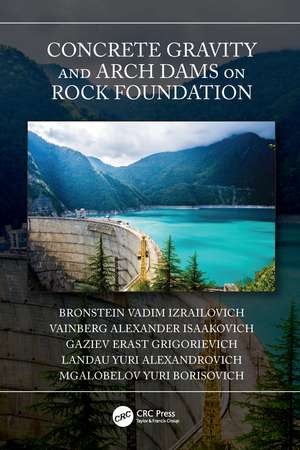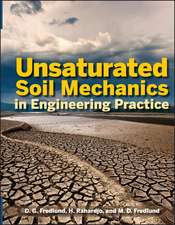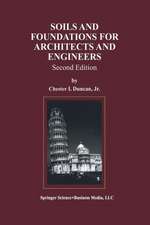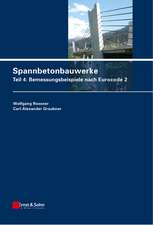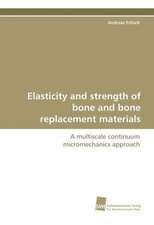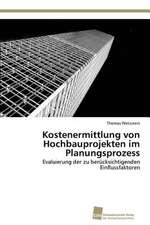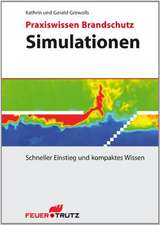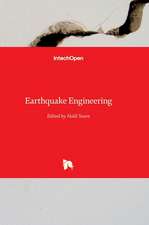Concrete Gravity and Arch Dams on Rock Foundation
Autor Bronstein Vadim Izrailovich, Vainberg Alexander Isaakovich, Gaziev Erast Grigorievich, Landau Yuri Alexandrovich, Mgalobelov Yuri Borisovichen Limba Engleză Hardback – 21 apr 2021
The book presents and analyzes the designs of erected concrete dams, which allows for a better understanding of the approaches and decision-making principles for designing dams, taking into account the specifics of natural, construction, and other conditions, and also analyzes a number of new solutions that reflect the various ways that engineering theory and practice has sought further improvement of concrete dams.
This work will be useful to hydraulic engineers and professionals involved in the design, construction, and operation of concrete dams, as well as in settlement studies. The book will also be of interest to academics and can be used as a textbook by university students specializing in hydraulic engineering.
| Toate formatele și edițiile | Preț | Express |
|---|---|---|
| Paperback (1) | 436.14 lei 6-8 săpt. | |
| CRC Press – 31 mai 2023 | 436.14 lei 6-8 săpt. | |
| Hardback (1) | 1357.48 lei 6-8 săpt. | |
| CRC Press – 21 apr 2021 | 1357.48 lei 6-8 săpt. |
Preț: 1357.48 lei
Preț vechi: 1655.46 lei
-18% Nou
Puncte Express: 2036
Preț estimativ în valută:
259.74€ • 271.22$ • 214.49£
259.74€ • 271.22$ • 214.49£
Carte tipărită la comandă
Livrare economică 15-29 aprilie
Preluare comenzi: 021 569.72.76
Specificații
ISBN-13: 9780367608316
ISBN-10: 0367608316
Pagini: 500
Ilustrații: 698
Dimensiuni: 174 x 246 x 27 mm
Greutate: 1.33 kg
Ediția:1
Editura: CRC Press
Colecția CRC Press
ISBN-10: 0367608316
Pagini: 500
Ilustrații: 698
Dimensiuni: 174 x 246 x 27 mm
Greutate: 1.33 kg
Ediția:1
Editura: CRC Press
Colecția CRC Press
Public țintă
Academic, Postgraduate, Professional, Professional Practice & Development, Undergraduate Advanced, and Undergraduate CoreCuprins
History of concrete dams development, Layouts of hydraulic projects with concrete dams, Rock foundation of dams, Connection of concrete dams with the foundation. Improvement of foundations, Concrete and reinforcement, Analysis of concrete dams, Gravity dams, Arch dams.
Notă biografică
Bronstein Vadim Izrailovich (19.01.1936–07.12.2011) graduated from the Moscow Institute of Water Management in 1959 as a hydraulic engineer. Doctor of Technical Sciences, Academician of the Russian Academy of Water Economics. He was one of the leading experts in the field of arch dam engineering, earthquake resistance of power structures, and control of their reliability and safety. He is known as the chief engineer of the Inguri arch dam design and the head of design work to stabilize the slope of the Zagorsk SPP. From 1962, he worked at JSC the Hydroproject Institute and from 1996 to 2011 as the Deputy Director for Safety and Monitoring of Structures of the CSGOES. He took an active part in the design of Hudoni arch dam in Georgia, the Toktogul HEP in Kirgizstan, the Rogun HEP in Tajikistan, the Kaseb HEP in Tunisia, Kapanda in Angola, and other HEP, SPP, and NPP in Russia and abroad. As a leader and direct executor, he participated in the development of programs for calculating the earthquake resistance of concrete and soil dams and underground structures and conducting full-scale studies of the earthquake resistance of HEP in Russia and abroad. He made a contribution to the comprehensive justification of the strength of arch dams and developed new design solutions and technological methods for regulating the SSS of structures. He is Member of ICOLD and ISRM, scientific and technical councils of the JSC Hydroproject Institute and RusHydro PJSC and the author of more than 140 publications in domestic and foreign editions, with five copyright certificates for inventions and computer programs. He is Honored Power Engineer of the CIS.
Vainberg Alexander Isaakovich was born on 15.06.1941 and graduated from the Ukrainian Institute of Water Engineers in 1963 as a hydraulic engineer. He is Doctor of Technical Science, Professor. After graduation, he served in the Soviet Army from 1966 to 1986 and was a graduate student, teacher, and assistant professor at the Ukrainian Institute of Water Management. Since 1986, he worked at the Ukrhydroproject Institute (Kharkov) as the chief specialist in calculating the strength and stability of HS; since 2005, he has been working as Deputy General Director of Ukrhydroproject PJSC. His design and scientific activities are associated with the justification of complex HP in Ukraine (Dnepr HEP, Dniester SPP), Russia, China, Vietnam, and other countries. He made a great contribution to the development of the method for calculating the SSS of dams, taking into account the phasing of their construction. He developed new methods for solving probabilistic problems of assessing the reliability of HS within the framework of the parametric and systemic theory of reliability. He is the author of a biexponential law, which in the best way to determine the extraordinary values of discharges in river Dnieper. He published the monograph "Formation of stresses in gravity dams", "Reliability and safety of HS. Selected problems" and others. At the same time, he is the head of the department of HS of Kharkov State Technical University of Construction and Architecture.
Gaziev Erast Grigorievich was born on 13.12.1931 and graduated in 1953 from the Hydrotechnical Department of the Moscow Power Engineering Institute (MPEI) and then from graduate school at the Department of Hydrotechnical Structures. In 1958, he defended his doctoral dissertation at MPEI and in 1980 at the Moscow Civil Engineering Institute defended his doctoral dissertation on the mechanics of rock masses. In 1958–1959, he worked as an engineer and lead engineer at the Institute of Geological Sciences of the Academy of Sciences of Armenia. In January 1960, he joined the Hydroproject Institute, where he was engaged in research on HS and their rocky foundations. He was the head of the research department of arch dams of the NIS Hydroproject. He participated in the research of many dams, including the Inguri arch and Sayano-Shushensk arch-gravity dam. In 1963, he completed an internship in Paris at the Coin and Bellier bureau. From 1966 to 1969, he worked as a UN expert in Mexico, where he organized research laboratories at the Ministry of Water Resources and the Ministry of Public Works. Under his leadership, research was carried out on a number of dams designed at that time, including the La Amistad dam (Mexico-USA) on the river Rio Grande. In 1994–2002, he was Researcher at the Institute of Engineering and professor at the Mexican Autonomous University in Mexico City, where he published the monograph "Rock Mechanics in Construction" and "Stability of Rock Formations and Methods of Fixing Them". He is the author of more than 200 publications, including 17 books in Russian, Spanish, and Serbian-Croatian. He was Chief Specialist of GSGOES RusHydro PJSC since 2002, Member of ISRM since 1972, and Chairman of the Russian Association of Geomechanics in the period of 2004–2018.
Landau Yuri Alexandrovich was born on March 21, 1939. He graduated from the Ukrainian Institute of Water Engineering in 1961 as a hydraulic engineer and graduated from postgraduate studies at VNIIG named after B.E. Vedeneeva. He was a candidate of technical sciences since 1969, doctor of technical sciences since 1999, full member of the Academy of Construction of Ukraine, and member of the International Energy Association (IEA). Since 1961, he has been working in the Ukrainian branch of the Hydroproject Institute JSC, where he has gone from an engineer to Deputy Director of Ukrhydroproject PJSC (Kharkov). Its activities are related to the scientific justification of HP, including environmental protection. He was the head of work on the scientific justification of new solutions for HS, including the study of stress state and optimization of the technology of erection of HS. He led the development of the state program for ensuring the environmental safety of HP. Under his leadership, innovative solutions were developed and implemented in the design and construction of the Kiev and Kanev HEP, the pumping stations of the feces Dnepr-Donbass, Tashlyksk SPP and the Aleksandrovsk HEP, the HEP Guaninge, and Chontenhe in China, Thakmo, Yali, and Nam Chien in Vietnam. He is one of the leading scientists in the field of hydropower, a member of the Ukrainian State Academy of Railway Transport, A scientific editor, and one of the authors of the encyclopedic publication "Energy: History, Present and Future". He is the author of more than 70 printed works in domestic and foreign publications, including monographs on concrete dams, hydropower, and environmental protection, with 125 copyright certificates and patents for inventions and three poetry collections. He is a member of ICOLD.
Mgalobelov Yuri Borisovich was born on 04.01.1942 and graduated from the Leningrad Polytechnic Institute as a hydraulic engineer. He is a candidate of technical sciences since 1973, a doctor of technical sciences since 1990, and a full member of the Russian Academy of Water Economics. In the years 1964–1980, he worked at the Hydroproject Institute as an engineer, team leader, chief specialist of the concrete dam department, and Deputy Chief Engineer of the project of the Middle Yenisei HEP. He took an active part in the design of the high-altitude arch dam of the Inguri, the arch-gravity dam of the Sayano-Shushensk HEP, the Toktogul concrete dam, and arch dams: Kasseb (Tunisia), Mansur Eddahbi (Morocco), and Kirdzhali (Bulgaria). In 1980–1989, as the head of the department of concrete structures, he led the scientific substantiation of the projects of arch dams of the Katun HEP and the Hudoni HEP in Georgia and concrete dams of the HP Kapanda (Angola), Kurpsay and Tashkumyr (Kirgizstan), Hoabin (Vietnam), Tashlyksk and Konstantinov (Ukraine), and Sangtudin (Tajikistan). He participated in the development of BR of the Gosstroy of the USSR for the design of concrete dams and their foundations in terms of new calculation methods for studying arch dams and their foundations in spatial conditions taking into account nonlinear effects, strength, and stability criteria, as well as in the development of engineering measures for strengthening rock foundations and slopes. Since 1989, he worked at the Hydroproject Institute as a chief specialist in the technical department, as a chief engineer, and as the head of the Center for Project Scientific Justification; he currently works as a scientific adviser to the Director General of Institute Hydroproject JSC. During this time, he led the justification of the projects of the HP Al-Baghdadi (Iraq), Teri (India), Merove (Sudan), Kudamkulam NPP (India), Shon La, Lai Chau, and Nam Chien (Vietnam), and Plyavinsk (Latvia). Since 1992, he has concurrently been Deputy General Director of the International Institute of Geomechanics and Hydrotechnics (IIGH) and Member of ICOLD and ISRM. He is the author of more than 160 publications, including 7 books and 4 certificates for inventions.
Vainberg Alexander Isaakovich was born on 15.06.1941 and graduated from the Ukrainian Institute of Water Engineers in 1963 as a hydraulic engineer. He is Doctor of Technical Science, Professor. After graduation, he served in the Soviet Army from 1966 to 1986 and was a graduate student, teacher, and assistant professor at the Ukrainian Institute of Water Management. Since 1986, he worked at the Ukrhydroproject Institute (Kharkov) as the chief specialist in calculating the strength and stability of HS; since 2005, he has been working as Deputy General Director of Ukrhydroproject PJSC. His design and scientific activities are associated with the justification of complex HP in Ukraine (Dnepr HEP, Dniester SPP), Russia, China, Vietnam, and other countries. He made a great contribution to the development of the method for calculating the SSS of dams, taking into account the phasing of their construction. He developed new methods for solving probabilistic problems of assessing the reliability of HS within the framework of the parametric and systemic theory of reliability. He is the author of a biexponential law, which in the best way to determine the extraordinary values of discharges in river Dnieper. He published the monograph "Formation of stresses in gravity dams", "Reliability and safety of HS. Selected problems" and others. At the same time, he is the head of the department of HS of Kharkov State Technical University of Construction and Architecture.
Gaziev Erast Grigorievich was born on 13.12.1931 and graduated in 1953 from the Hydrotechnical Department of the Moscow Power Engineering Institute (MPEI) and then from graduate school at the Department of Hydrotechnical Structures. In 1958, he defended his doctoral dissertation at MPEI and in 1980 at the Moscow Civil Engineering Institute defended his doctoral dissertation on the mechanics of rock masses. In 1958–1959, he worked as an engineer and lead engineer at the Institute of Geological Sciences of the Academy of Sciences of Armenia. In January 1960, he joined the Hydroproject Institute, where he was engaged in research on HS and their rocky foundations. He was the head of the research department of arch dams of the NIS Hydroproject. He participated in the research of many dams, including the Inguri arch and Sayano-Shushensk arch-gravity dam. In 1963, he completed an internship in Paris at the Coin and Bellier bureau. From 1966 to 1969, he worked as a UN expert in Mexico, where he organized research laboratories at the Ministry of Water Resources and the Ministry of Public Works. Under his leadership, research was carried out on a number of dams designed at that time, including the La Amistad dam (Mexico-USA) on the river Rio Grande. In 1994–2002, he was Researcher at the Institute of Engineering and professor at the Mexican Autonomous University in Mexico City, where he published the monograph "Rock Mechanics in Construction" and "Stability of Rock Formations and Methods of Fixing Them". He is the author of more than 200 publications, including 17 books in Russian, Spanish, and Serbian-Croatian. He was Chief Specialist of GSGOES RusHydro PJSC since 2002, Member of ISRM since 1972, and Chairman of the Russian Association of Geomechanics in the period of 2004–2018.
Landau Yuri Alexandrovich was born on March 21, 1939. He graduated from the Ukrainian Institute of Water Engineering in 1961 as a hydraulic engineer and graduated from postgraduate studies at VNIIG named after B.E. Vedeneeva. He was a candidate of technical sciences since 1969, doctor of technical sciences since 1999, full member of the Academy of Construction of Ukraine, and member of the International Energy Association (IEA). Since 1961, he has been working in the Ukrainian branch of the Hydroproject Institute JSC, where he has gone from an engineer to Deputy Director of Ukrhydroproject PJSC (Kharkov). Its activities are related to the scientific justification of HP, including environmental protection. He was the head of work on the scientific justification of new solutions for HS, including the study of stress state and optimization of the technology of erection of HS. He led the development of the state program for ensuring the environmental safety of HP. Under his leadership, innovative solutions were developed and implemented in the design and construction of the Kiev and Kanev HEP, the pumping stations of the feces Dnepr-Donbass, Tashlyksk SPP and the Aleksandrovsk HEP, the HEP Guaninge, and Chontenhe in China, Thakmo, Yali, and Nam Chien in Vietnam. He is one of the leading scientists in the field of hydropower, a member of the Ukrainian State Academy of Railway Transport, A scientific editor, and one of the authors of the encyclopedic publication "Energy: History, Present and Future". He is the author of more than 70 printed works in domestic and foreign publications, including monographs on concrete dams, hydropower, and environmental protection, with 125 copyright certificates and patents for inventions and three poetry collections. He is a member of ICOLD.
Mgalobelov Yuri Borisovich was born on 04.01.1942 and graduated from the Leningrad Polytechnic Institute as a hydraulic engineer. He is a candidate of technical sciences since 1973, a doctor of technical sciences since 1990, and a full member of the Russian Academy of Water Economics. In the years 1964–1980, he worked at the Hydroproject Institute as an engineer, team leader, chief specialist of the concrete dam department, and Deputy Chief Engineer of the project of the Middle Yenisei HEP. He took an active part in the design of the high-altitude arch dam of the Inguri, the arch-gravity dam of the Sayano-Shushensk HEP, the Toktogul concrete dam, and arch dams: Kasseb (Tunisia), Mansur Eddahbi (Morocco), and Kirdzhali (Bulgaria). In 1980–1989, as the head of the department of concrete structures, he led the scientific substantiation of the projects of arch dams of the Katun HEP and the Hudoni HEP in Georgia and concrete dams of the HP Kapanda (Angola), Kurpsay and Tashkumyr (Kirgizstan), Hoabin (Vietnam), Tashlyksk and Konstantinov (Ukraine), and Sangtudin (Tajikistan). He participated in the development of BR of the Gosstroy of the USSR for the design of concrete dams and their foundations in terms of new calculation methods for studying arch dams and their foundations in spatial conditions taking into account nonlinear effects, strength, and stability criteria, as well as in the development of engineering measures for strengthening rock foundations and slopes. Since 1989, he worked at the Hydroproject Institute as a chief specialist in the technical department, as a chief engineer, and as the head of the Center for Project Scientific Justification; he currently works as a scientific adviser to the Director General of Institute Hydroproject JSC. During this time, he led the justification of the projects of the HP Al-Baghdadi (Iraq), Teri (India), Merove (Sudan), Kudamkulam NPP (India), Shon La, Lai Chau, and Nam Chien (Vietnam), and Plyavinsk (Latvia). Since 1992, he has concurrently been Deputy General Director of the International Institute of Geomechanics and Hydrotechnics (IIGH) and Member of ICOLD and ISRM. He is the author of more than 160 publications, including 7 books and 4 certificates for inventions.
Recenzii
This volume is coauthored by five prominent Russian and Ukrainian authorities on concrete dams. Following an introductory chapter on the history of dams, the authors turn to various aspects of concrete dam technology: general layout of dam projects, dam foundations, concrete and reinforced concrete dams, mathematical analysis, and issues specific to concrete gravity and concrete arch dams, paying special attention to the relatively new technique of rolled concrete. This compilation provides a good technical overview of the many issues involved in hydraulic projects, especially because the authors use examples from existing dams to illustrate their points. While it will be useful to hydraulic engineers, the volume is narrowly technical. The historical chapter, for example, is primarily a listing of dams, including dates of construction and dimensions, but with little attempt to place them in a social context or use the literature on dams by professional historians. Likewise, the volume devotes little space to the environmental impact of dams and how this has led to growing resistance to large dam projects. The translation from Russian is awkward at points, and the index is sketchy. The target audience for this work may be readers interested in the careers of these particular authors, all civil engineers born and educated during the Soviet period.
T. S. Reynolds, emeritus, Michigan Technological University
T. S. Reynolds, emeritus, Michigan Technological University
Descriere
Presents and analyzes the designs of concrete dams, allowing for a better understanding of the approaches and decision-making principles for designing dams. Useful to hydraulic engineers and professionals involved in concrete dams or settlement studies, and as a textbook for university students.
